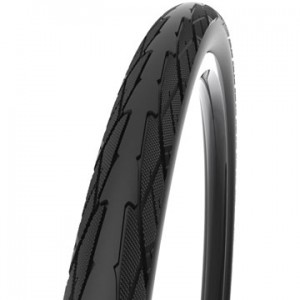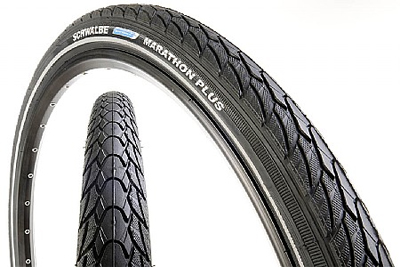We’ve fallen behind, the days are getting shorter and of course, the rain has arrived. We bundle up, pull on the rain pants, strap on the fenders on and carry our bike lights everywhere we go.
Seems like we’re all set for winter, right?
Almost. While these steps definitely made your ride comfortable and visible, there are a few additional steps you can take to make your ride even safer this winter.
1. Go Low
Using a pump with a gauge, fill your tires about 5psi (pound per square inch) less than you normally would. For example, if you normally fill them to 105psi in the back and 95psi in the front (a little less in the front helps with steering and traction, but that’s another article), drop your inflation down to 100psi in the back and 90psi in the front for the winter. You won’t lose much speed, if any, and you’ll end up with a wider contact patch with the ground. This is essential to maintaining good traction – especially cornering over wet leaves and riding over fallen sticks, branches and wet metal.
2. Toughen up Your Tires
Rain, unfortunately for us, is a lubricant. It’s what makes leaf-strewn streets extra slick. It’s also the reason you get more flats in winter. When the glass and debris on the road is wet, it can more easily slide into the rubber of your tire – leaving you to fix a flat in the wet and cold – a most unpleasant experience.
After lowering your inflation, the next best thing you can do to improve traction and prevent flats is to put on a winter tire with increased puncture protection and a little bit of water dispersion in the tread. The puncture protection – usually made of Kevlar – can be tricky. A super tough tire is also less pliable and conforms less to the road, especially in the cold. That’s where a lower inflation will be key to creating a more supple tire.
Also, look for a tire with a water-dispersion tread. Usually the tread is mostly smooth with small, wave shaped etchings toward the sides of the tread. What will that look like? See some examples below.
Some people think that riding a tire with knobs will keep them safer in the winter but unless you’re riding strictly on mud, gravel or any other soft surface this is a bad idea. Knobby tires actually make less contact with pavement so you end up with less traction on the road than you would otherwise. This makes it both harder to pedal and less safe, a no win situation.
3. Soften up your Pads
Our wet, humid winters wreak havoc on rims. It not only wears them down but in the process makes it much harder to stop quickly. Switching to a wet-weather brake pad not only will give you increased braking power, but also increase the life of your wheels, one of the most expensive parts on your bike to replace.
My favorite pads are by the Lake Oswego-based company Kool Stop. Most local bike shops carry their excellent “Salmon” pads (which are sort of a salmon color). They wear slightly faster than “all-weather” pads but will dramatically increase your braking power and rim life. In the long run, this small investment can preserve the life of your wheels, and quite possibly your life as well.
4. Set Aside a Day
Don’t put it off any longer. Carve out a day to attend to these small changes that will make a huge difference. If you aren’t up for the challenging of doing the work yourself, contact your local bike shop. Many will allow you to schedule a tune-up so you don’t have to be apart from your bike while waiting for the work to be done. And, with these being relatively minor adjustments, most shops will be able to attend to them relatively quickly. If you ride regularly and consistently wear down your brake pads, consider getting the cartridge style, which are infinitely easier to replace at home as they only require sliding the pad into the cartridge (through it does take a fair bit of finger power.)
Types of Tire Tread
What are Your tips?
How do you modify your bike for winter riding?





You might be surprised that you get less flats in snow than any other kind of weather. I know this wasn’t written for freaking Canadians.
Picos – doesn’t surprise me at all that you get fewer flats in snow. The snow covers road debris.
Yah, we get some snow here in Oregon, like an inch of it. ha ha!
(but hay, we like Canadians!!!)
Bicycle tires do not need (nor do the benefit from) “water displacement channels.” Hydroplaning is simply not an issue. On a typical 25 mm road tire, any channels or tread will reduce the contact patch. But don’t trust me– Google it!
Biggest thing you can do to make wet cycling more enjoyable: A big flap on the front fender. The English have been using them forever. A really good flap can be made from thin graphics film like was popular 20 years ago for presentations. The secret is that it is too flexible. So you double it up. First, drill out the rivets for the bottom stays. Cut out 2 identical flaps, lay one on top of the other and tape the edges with clear packing tape. Then fasten with screws and locknuts through the holes you drilled out. A short piece of bent spoke can be taped midway down the flap to hold it in a neat “U”.
Advantages of the flap? The big one is that when you wheel the bike off a sidewalk and hang the bike up on the fender flap or pull of the front wheel to lock the bike, the flap does not care. And even bigger, it will never break the fender it is attached too. There is also the chance that a big stick will simply fold the flap back, not jam. I have hit things that have done that without me seeing what the culprit was. I’ve cursed that I had to stop and straighten out the flap, but I probably should have been saying my thanks for the crash that did not happen.
Very interesting? Can u recommend a store that might carry thin graphics film? Thanks!
Great tip, Ben! I did a full write-up on fenders last year, but this is a super useful idea.
4 Tips for Safer Winter Ride. Make your bike even safer this winter from expert @GraciesWrench http://t.co/AwigKmeyXG #KeepRiding
4 Expert Tips for Safer Winter Ride. Make your bike even safer this winter: Tips from Tori Bortman of @GraciesWrench http://t.co/KcrLPKkAq3
4 Expert Tips for a Safer Winter Ride : ORbike http://t.co/4LI5vjE8Gp, see more http://t.co/OLtE7DvaZI
RT @ORbike: 4 Tips for Safer Winter Ride. Make your bike even safer this winter from expert @GraciesWrench http://t.co/AwigKmeyXG #KeepRidi…
RT @ORbike 4 Expert Tips for Safer Winter Ride. Make your bike even safer this winter: Tips from @GraciesWrench http://t.co/sJ4jKTgHaC
RT @ORbike 4 Expert Tips for Safer Winter Ride. Make your bike even safer this winter: Tips from @GraciesWrench http://t.co/9i8CTRl0w8
RT @FilmedByBike: RT @ORbike 4 Expert Tips for Safer Winter Ride. Make your bike even safer this winter: Tips from @GraciesWrench http://t.…
RT @FilmedByBike: RT @ORbike 4 Expert Tips for Safer Winter Ride. Make your bike even safer this winter: Tips from @GraciesWrench http://t.…
4 Expert Tips for Safer Winter Ride. Make your bike even safer this winter, by @GraciesWrench http://t.co/AwigKmeyXG #KeepRiding
RT @ORbike: 4 Expert Tips for Safer Winter Ride. Make your bike even safer this winter, by @GraciesWrench http://t.co/AwigKmeyXG #KeepRiding